Suzuki harunobu 159975-Suzuki harunobu obras
Suzuki Harunobu (Japanese 鈴木 春信;Suzuki Harunobu Japanese Of all ukiyoe prints of lovers, this one creates the most romantic and melancholic mood Harunobu emphasizes the intimacy of two lovers strolling in the snow, even suggesting perhaps a michiyuki, a path to a love suicideC 1725 – 15 July 1770) was a Japanese designer of woodblock print art in the Ukiyoe style He was an innovator, the first to produce fullcolor prints in 1765, rendering obsolete the former modes of two and threecolor printsHarunobu used many special techniques, and depicted a wide variety of subjects, from classical poems to contemporary beauties

Bonhams Suzuki Harunobu 1725 1770 Edo Period 1615 1868 Circa 1765
Suzuki harunobu obras
Suzuki harunobu obras-From Sun Art Space Gallery , Suzuki Harunobu, 八つ橋 (Heian period), Japanese Woodblock Print, 252 × 213 cmSuzuki Harunobu The romance of Harunobu's art is ascribable, on one hand, to his personality, and, on the other, to his attempt to introduce the feeling of real life into the conventionalized " beauty pictures"



Evening Glow Of The Lamp Later Edition Suzuki Harunobu Publisher Yamashiroya Mia
Benzaiten, from the series "The Seven Gods of Good Luck in the Floating World (Ukiyo Shichi Fukujin)", c 1769 Suzuki Harunobu;Suzuki Harunobu was a Japanese designer of woodblock print art in the Ukiyoe style He was an innovator, the first to produce fullcolor prints (nishikie) in 1765, rendering obsolete the former modes of two and threecolor printsDescription AFTER SUZUKI HARUNOBU (, Japan) WOMAN AND RAIJIN Color woodblock reproduction print of a woman in traditional Japanese clothing underneath a dark cloud with the Shinto god of lightning with his drums stacked high Original seals are present on the work along with a double circle seal attributed to Goyo Hashiguchi () Condition excelle
Suzuki Harunobu (鈴木 春信?, 1725?– July 7, 1770) was a Japanese woodblock print artist, one of the most famous in the Ukiyoe style He was an innovator, the first to produce fullcolor prints in 1765, rendering obsolete the former modes of two and threecolor printsHarunobu used many special techniques, and depicted a wide variety of subjects, from classical poems to contemporarySuzuki Harunobu Ise, from an untitled series of Thirtysix Immortal Poets, c 1767/68 DoubleFlowered Cherry Motoura of the Minami Yamasakiya (Minami Yamasakiya uchi Motoura, Yaezakura), from the series "Beauties of the Floating World Compared to Flowers (Ukiyo bijin hana ni yosu)", c 1768/1769Suzuki Harunobu, Japanese Shunga Art Print Caught Redhanded Suzuki Harunobu (c 1725 – 7 July 1770) was a Japanese designer of woodblock print artist in the Ukiyoe style He was an innovator, the first to produce fullcolor prints (nishikie) in 1765, rendering obsolete the former modes of two and threecolor prints
Suzuki Harunobu (Japanese 鈴木 春信;While little is known about his early life, Harunobu Suzuki (né Hozumi) was a ukiyoe artist that lived and worked in Edo Said to have been the student of Shigenaga, Harunobu's early actor prints suggest the strong influence of Toyonobu, Sukenobu and the Torii schoolSuzuki Harunobu, ca Elegant Erotic Mane'emon (Furyu Enshoku Mane'emon) complete set of twelve prints with forward from the first volume of the twovolume publication (13 sheets), published by Nishimuraya Yohachi, ca each chuban yokoe approximately 8 3/8 by 11 1/2 in, 212 by 292 cm This set of twelve prints, in remarkably pristine conditions, is from the first album



Evening Glow Of The Lamp Later Edition Suzuki Harunobu Publisher Yamashiroya Mia
_-_(MeisterDrucke-95051).jpg)


The Cockfight Woodblock Print By Suzuki Harunobu
Japanese Woodblock prints by Suzuki Harunobu 1,1 prints found Viewing prints 100 to 0Suzuki Harunobu (Japanese 鈴木 春信;This work by Suzuki Harunobu features a pair of the artist's characteristically petite figures a courtesan (yūjo) and her young attendant (kamuro) The standing woman's identity as a yūjo is manifested in the details of her dress yūjo typically wore their sash tied to the front and were always depicted barefoot, without the splittoed



Suzuki Harunobu Wikipedia



Suzuki Harunobu And The Culture Of Color Portland Art Museum
Shop AllPosterscom to find great deals on Suzuki Harunobu Posters for sale!Japanese Woodblock prints by Suzuki Harunobu 1,1 prints found Viewing prints 1 to 100Suzuki Harunobu An Exhibition of His Colourprints and Illustrated Books on the occasion of the bicentenary of his death in 1770 by Hillier, Jack Ronald Missing dust jacket;



Amazon Com Mother And Daughter By Suzuki Harunobu 1724 1770 Posters Prints



Viewing Japanese Prints Suzuki Harunobu 鈴木春信
Suzuki Harunobu (ca ) was one of the six great masters of the Japanese woodblock print and was responsible for inventing the fully developed color print called nishikie, or brocade paintingHarunobu Suzuki is associated with the word nishikie, which means literally brocade printsIn a wider sense nishikie stands for prints made in several colors Harunobu is referred as the inventor of Japanese color prints Today we know that Harunobu certainly was not the first to make the step from black and white to multicolor prints But he was the first to take full advantage of the newC 1725 – 15 July 1770) was a Japanese designer of woodblock print art in the Ukiyoe style He was an innovator, the first to produce fullcolor prints in 1765, rendering obsolete the former modes of two and threecolor printsHarunobu used many special techniques, and depicted a wide variety of subjects, from classical poems to contemporary beauties



Eight Views Early Morning Mist In Ogi Painting By Suzuki Harunobu Reproduction 1st Art Gallery
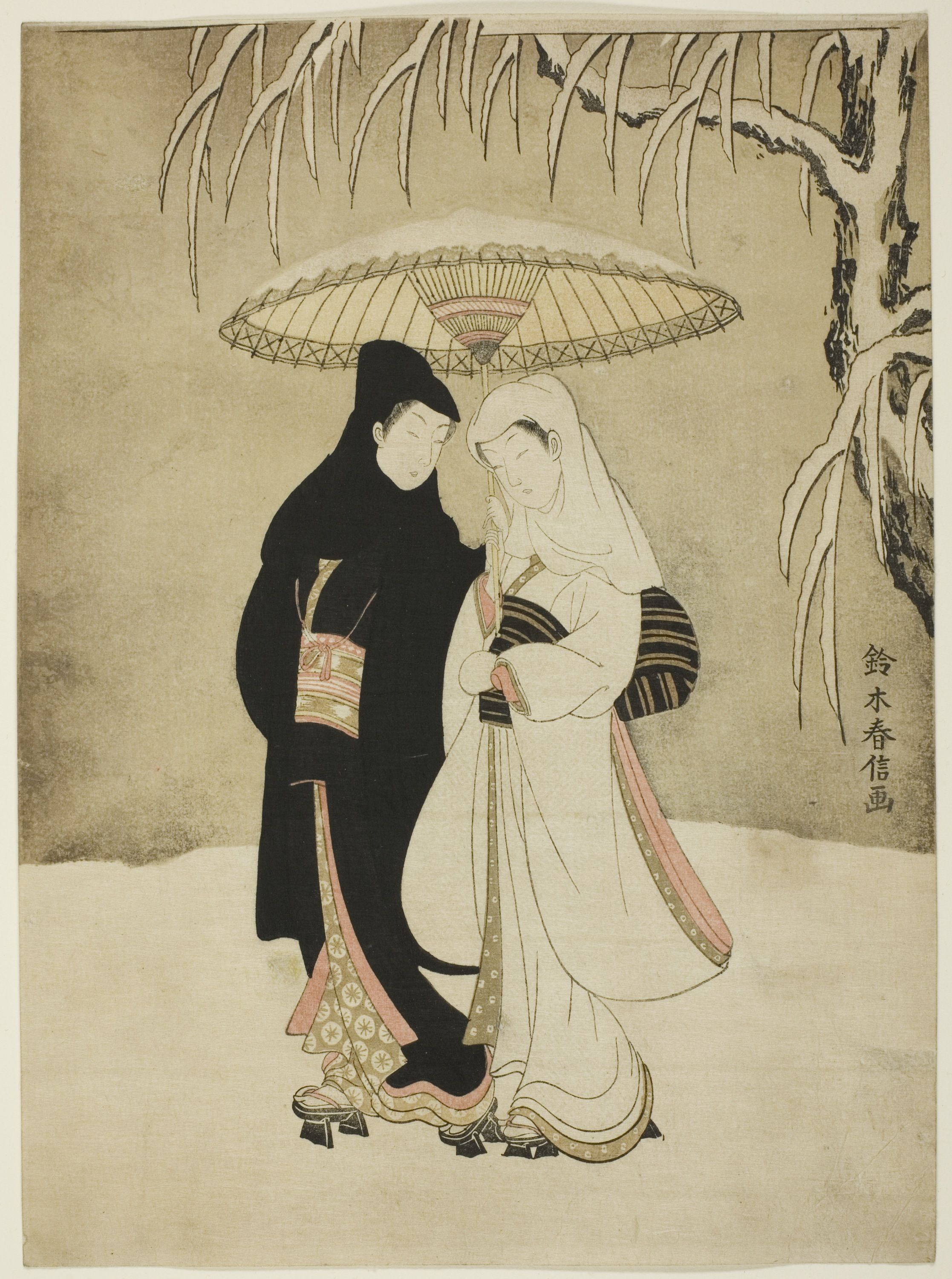


Suzuki Harunobu Wikipedia
Harunobu Suzuki is associated with the word nishikie, which means literally brocade printsIn a wider sense nishikie stands for prints made in several colors Harunobu is referred as the inventor of Japanese color prints Today we know that Harunobu certainly was not the first to make the step from black and white to multicolor prints But he was the first to take full advantage of the newAttributed to Suzuki Harunobu (1725?1770) Two designs from the series Furyu zashiki hakkei Fashionable Eight Views of the Parlour Room, the first a woman creeps across the room while a couple have an encounter;C 1725 – 15 July 1770) was a Japanese designer of woodblock print art in the Ukiyoe style He was an innovator, the first to produce fullcolor prints (nishikie) in 1765, rendering obsolete the former modes of two and threecolor prints



Japanese Ukiyo E Woodblock Print Suzuki Harunobu Etsy
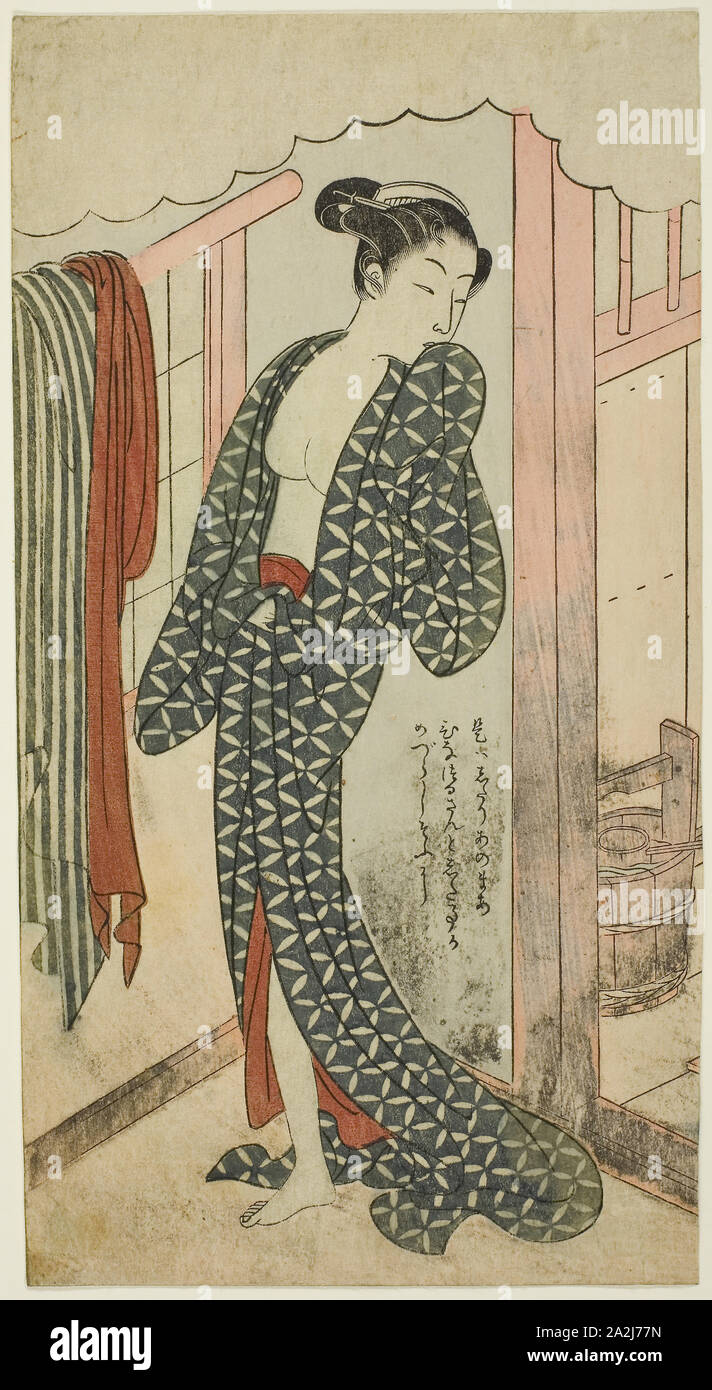


Woman In A Bathhouse C 1769 70 Suzuki Harunobu 鈴木 春信 Japanese 1725 1770 Japan Color Woodblock Print Cut From Chuban Sheet 8 1 2 X 4 1 2 In Stock Photo Alamy
Zashiki Hakkei (Japanese 坐敷八景, "Eight Parlour Views") is a series of eight prints from 1766 by the Japanese ukiyoe artist Suzuki HarunobuThey were the first fullcolour nishikie prints and are considered representative examples of Harunobu's work The prints are mitatee parodies of popular themes of the 11thcentury Chinese landscape painting series, Eight Views of XiaoxiangSuzuki Harunobu Japanese In Harunobu's artistic vision, the interior life is defined by its relationship to the exterior world In all three Harunobu prints in this exhibition, though the figures are placed suggestively close to the outside, their activities allude to the intimacy of the domestic realmSuzuki Harunobu (1725 – 1770) was a Japanese designer of woodblock print artist in the Ukiyoe style He was an innovator, the first to produce fullcolor prints (nishikie) in 1765, rendering obsolete the former modes of two and threecolor prints
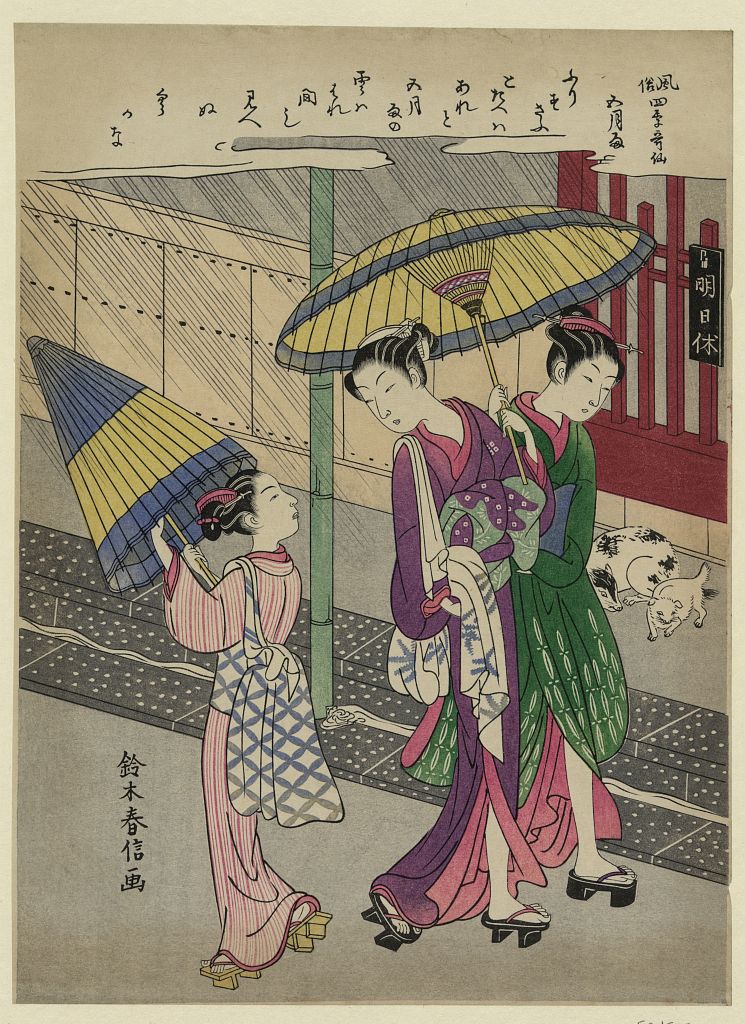


Suzuki Harunobu Rain In May Library Of Congress Ukiyo E Search


Suzuki Harunobu Night Rain At The Double Shelf Stand From The Series Eight Parlor Views Zashiki Hakkei Japan Edo Period 1615 1868 The Metropolitan Museum Of Art
Suzuki Harunobu The romance of Harunobu's art is ascribable, on one hand, to his personality, and, on the other, to his attempt to introduce the feeling of real life into the conventionalized " beauty pictures"A Young Woman in a Summer Shower, 1765 Suzuki Harunobu;Suzuki Harunobu Two Young Women Reading Books, c 1767/68 Sumirena The Mistress of Yojiya (Yojiya musume, Sumirena), from the series "Beauties of the Floating World Compared to Flowers (Ukiyo bijin hana ni yosu)", c 1768/69



Suzuki Harunobu 1724 1770 Autumnal Interior



Brooklyn Museum
Courtesan Writing a Letter as Two Men Watch through a Window Lattice, cC 1725 – 7 July 1770) was a Japanese designer of woodblock print artist in the Ukiyoe style He was an innovator, the first to produce fullcolor prints in 1765, rendering obsolete the former modes of two and threecolor printsHarunobu used many special techniques, and depicted a wide variety of subjects, from classical poems to contemporarySuzuki Harunobu >Suzuki Harunobu (ca ) was one of the six great masters of the >Japanese woodblock print and was responsible for inventing the fully >developed color print called nishikie, or brocade painting



Suzuki Harunobu Japanese Art Print Kite Flying Gallerythane
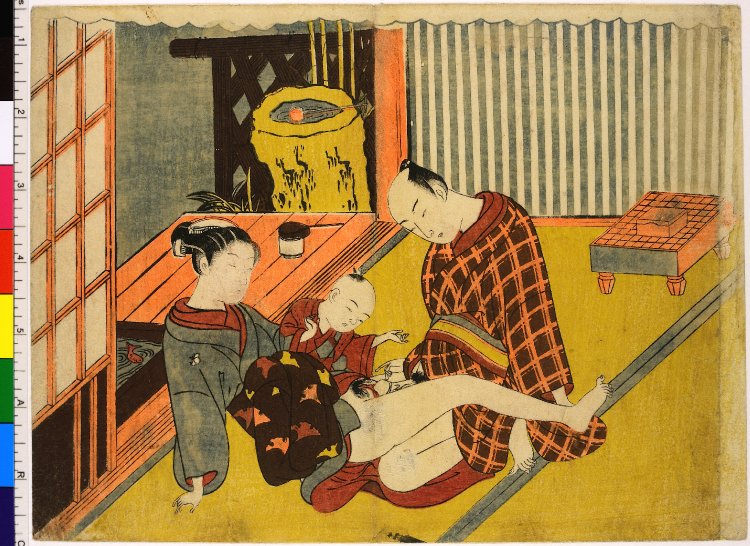


Suzuki Harunobu Shunga Print British Museum Ukiyo E Search
Suzuki Harunobu was a Japanese designer of woodblock print art in the Ukiyoe style He was an innovator, the first to produce fullcolor prints (nishikie) in 1765, rendering obsolete the former modes of two and threecolor printsThe second Evening Bell, both good impressions, slight creasing and wear to edges Chuban yokoe (2)Hotoke Gozen Dancing before Taira no Kiyomori, 1765 Suzuki Harunobu;



Japanese Art Japanese Prints Ukiyo E Woodblock Prints Suzuki Harunobu



Antique Vintage Signed Suzuki Harunobu 2 Laides Washing Hiar Japanese Woodblock Ebay
Suzuki Harunobu wall art for home and office decor Discover canvas art prints, photos, mural, big canvas art and framed wall art in GreatBigCanvascom's varied collectionsHarunobu's print displays the different levels of meaning that combine to create a complicated narrative Initially, the series is a variation on the traditional theme of the ' Eight Views of Omi (Omi hakkei)' , which was also parodied by Harunobu in his earlier renowned series ' Eight Parlour Views (Zashiki hakkei, 1766)'Suzuki Harunobu (1725?1770) Risshu (The Start of Autumn), from the series Fuzoku shiki kasen (The Series of Popular Versions of the Immortal Poets in the Four Seasons), 1768 Woodcut set within a room just off a veranda of a courtesan fresh from the bath, her striped robe slipped casually off her left shoulder and held loosely by her child attendant as both are distracted by something outside



The Second Month Drawing By Suzuki Harunobu


Suzuki Harunobu The Music Lesson Japan Edo Period 1615 1868 The Metropolitan Museum Of Art
Artist Suzuki Harunobu (), Title The Evening Glow of a Lamp, from the series "Eight Views of the Parlor", Date 1766, Collection The Art Institute of Chicago, Information from/Photographed by The Art Institute of Chicago peinture Peinture japonaise Contenu associéSuzuki Harunobu, ca Elegant Erotic Mane'emon (Furyu Enshoku Mane'emon) complete set of twelve prints with forward from the first volume of the twovolume publication (13 sheets), published by Nishimuraya Yohachi, ca each chuban yokoe approximately 8 3/8 by 11 1/2 in, 212 by 292 cm This set of twelve prints, in remarkably pristine conditions, is from the first albumShop Artcom for the best selection of Suzuki Harunobu wall art online Low price guarantee, fast shipping & free returns, and custom framing options on all prints



Suzuki Harunobu Buy At Veryimportantlot Com Auction Of The Artwork Suzuki Harunobu 1725 1770 Artist Suzuki Harunobu At A Low Price Catalog From 22 09 Lot 150


Q Tbn And9gct2bsl 3iq0 51kiu4s9uiiqhy4i Sqldwwhmczd7hrtmamrwdb Usqp Cau
Suzuki Harunobu (Japanese 鈴木 春信;Available for sale from Ronin Gallery, Suzuki Harunobu, Autumn (ca 1768), Japanese woodblock print, 11 × 8 1/4 inWe offer a huge selection of posters & prints online, with big discounts, fast shipping, and custom framing options you'll love



Suzuki Harunobu Ca 1724 70 Three Evenings Autumn Evening By The Marsh With Sandpiper Signed S Japanese Woodblock Printing Japanese Prints Japan Painting



Suzuki Harunobu 1725 1770 Japanese Woodblock Print Chairish
Pages can have notes/highlighting Spine may show signs of wear ~ ThriftBooks Read More, Spend LessC 1725 – 15 July 1770) was a Japanese designer of woodblock print art in the Ukiyoe style He was an innovator, the first to produce fullcolor prints (nishikie) in 1765, rendering obsolete the former modes of two and threecolor printsShop for suzuki harunobu art from the world's greatest living artists All suzuki harunobu artwork ships within 48 hours and includes a 30day moneyback guarantee Choose your favorite suzuki harunobu designs and purchase them as wall art, home decor, phone cases, tote bags, and more!



Art On Tuesday Suzuki Harunobu Japan Kaleidoskop



Ukiyo E Woodblock Print Reprint Suzuki Harunobu Catawiki
View Suzuki Harunobu's artworks on artnet Learn about the artist and find an indepth biography, exhibitions, original artworks, the latest news, and sold auction pricesArtist Suzuki Harunobu (), Title The Evening Glow of a Lamp, from the series "Eight Views of the Parlor", Date 1766, Collection The Art Institute of Chicago, Information from/Photographed by The Art Institute of Chicago peinture Peinture japonaise Contenu associéSuzuki Harunobu, Night Rain at the DoubleShelf Stand, from the series Eight Parlor Views, ca 1766, Japanese Art, Art Print Giclee UnbelievablePrints From shop UnbelievablePrints 5 out of 5 stars (21) 21 reviews $ 1574 Favorite Add to
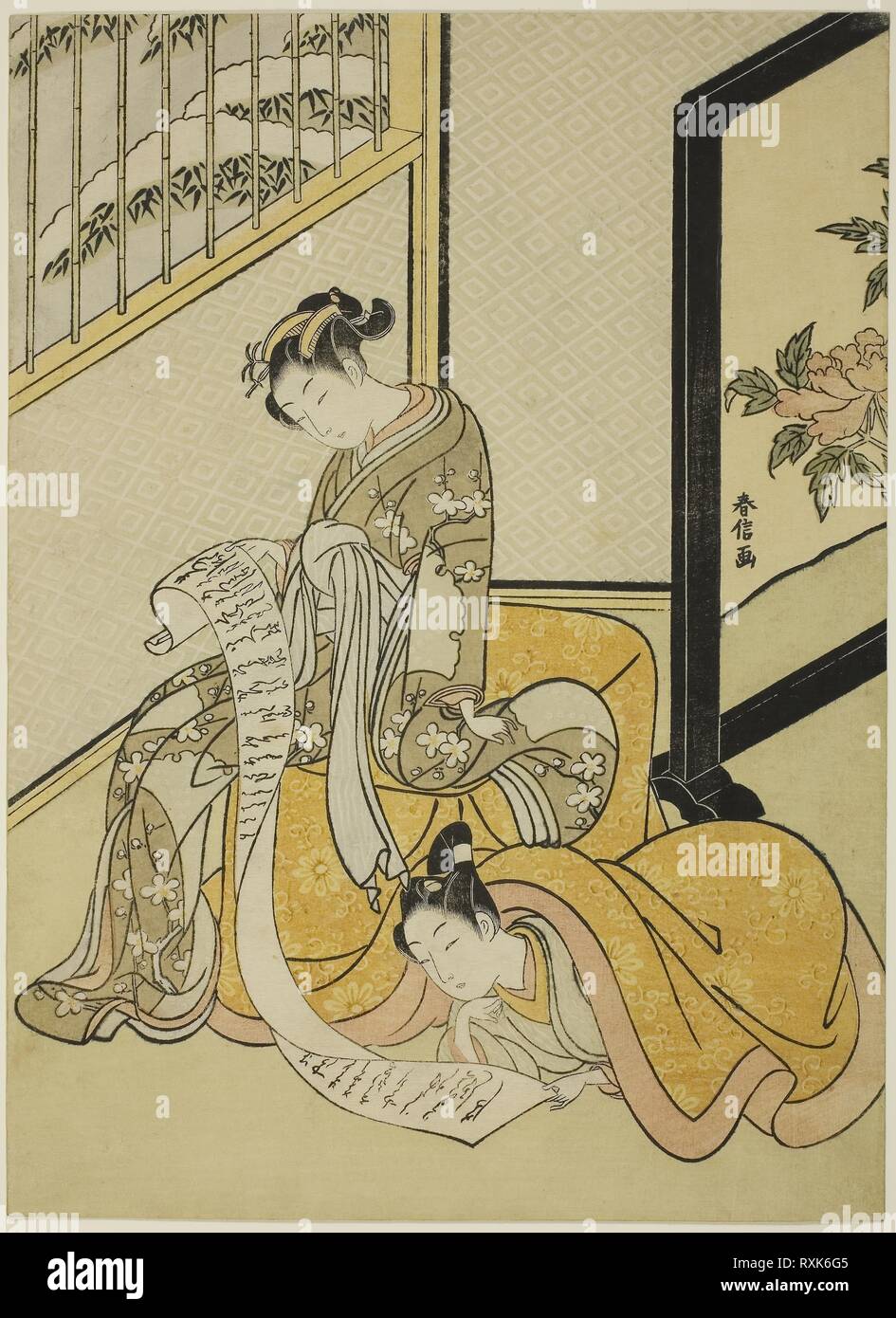


Couple Reading A Letter Suzuki Harunobu Japanese 1725 1770 Date 1765 1770 Dimensions 10 3 4 X 8 In Color Woodblock Print Chuban Origin Japan Museum The Chicago Art Institute Stock Photo Alamy
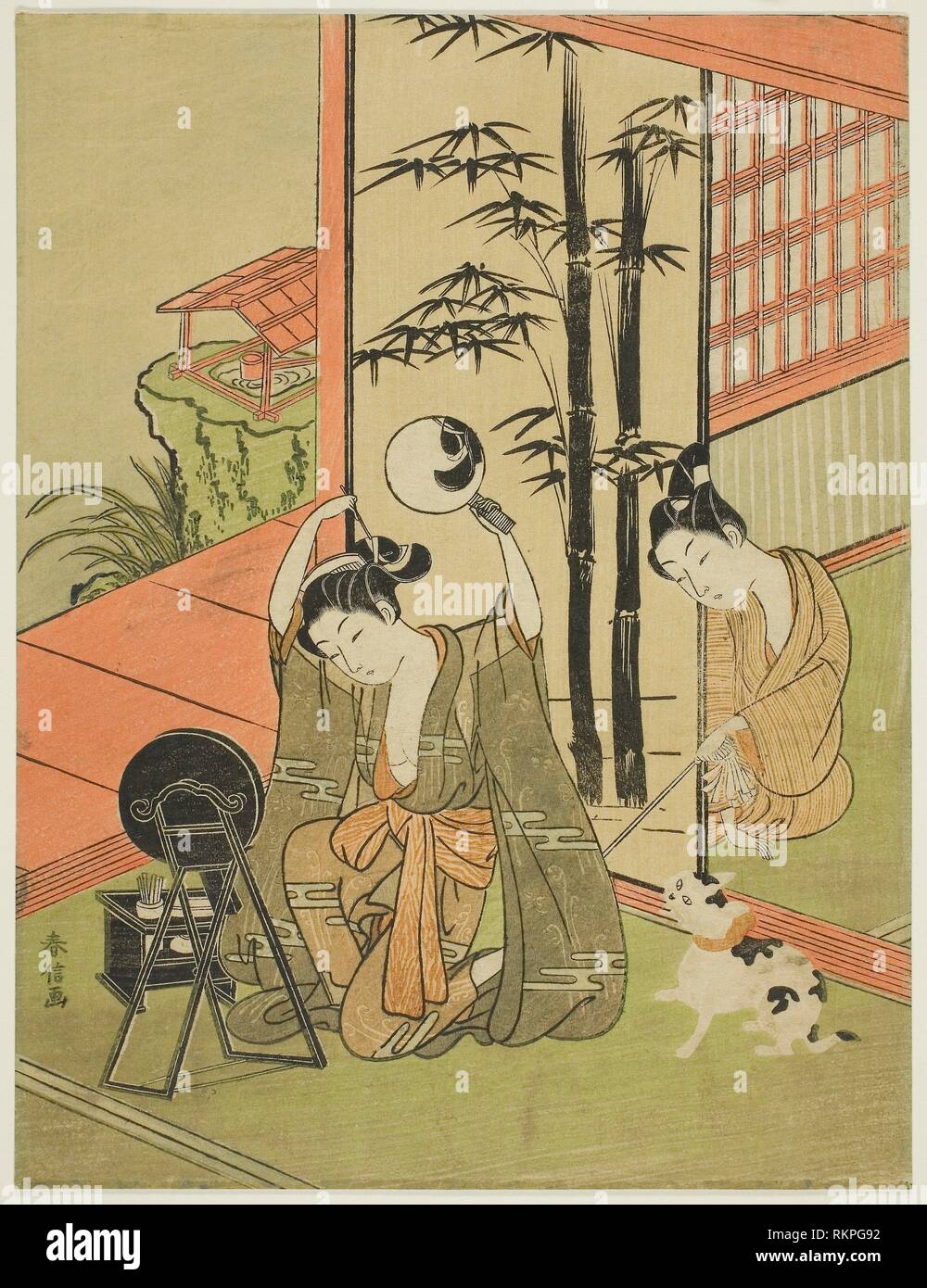


Tickling Her Foot C 1765 70 Suzuki Harunobu Japanese 1725 1770 Artist Suzuki Harunobu Origin Japan Date 1760 1770 Medium Stock Photo Alamy
Suzuki Harunobu (Japanese 鈴木 春信;Shop for suzuki harunobu art from the world's greatest living artists All suzuki harunobu artwork ships within 48 hours and includes a 30day moneyback guarantee Choose your favorite suzuki harunobu designs and purchase them as wall art, home decor, phone cases, tote bags, and more!Attributed to Suzuki Harunobu (1725?1770) Two designs from the series Furyu zashiki hakkei Fashionable Eight Views of the Parlour Room, the first a woman creeps across the room while a couple have an encounter;



Ono No Komachi Praying For Rain Relief By Suzuki Harunobu



Suzuki Harunobu 22 Artworks Bio Shows On Artsy
Suzuki Harunobu Japanese In Harunobu's artistic vision, the interior life is defined by its relationship to the exterior world In all three Harunobu prints in this exhibition, though the figures are placed suggestively close to the outside, their activities allude to the intimacy of the domestic realmArtist Suzuki Harunobu (), Title Lovers Beneath an Umbrella in the Snow, Date 1767, Collection The Art Institute of Chicago, Information from/Photographed by The Art Institute of ChicagoSuzuki Harunobu, original name Hozumi Harunobu, pseudonym (gō) Chōeiken, or Shikojin, popular name (tsūshō) Jirobei, or Jihei, (born 1725?, Edo now Tokyo, Japan—died July 8, 1770, Edo), Japanese artist of the Ukiyoe movement (paintings and woodblock prints of the "floating world"), who established the art of nishikie, or polychrome prints



Suzuki Harunobu Antique Japanese Woodblock Print Geisha 8 Fashionable Tangrams Ruby Lane



Suzuki Harunobu And The Culture Of Color Portland Art Museum
Japanese Woodblock prints by Suzuki Harunobu 1,1 prints found Viewing prints 100 to 0Suzuki Harunobu (鈴木春信 active c 1760 died 1770) is celebrated for his ethereal female figures, winsome in demeanor and fragile of substanceThe second Evening Bell, both good impressions, slight creasing and wear to edges Chuban yokoe (2)



Suzuki Harunobu Alchetron The Free Social Encyclopedia



Young Woman Jumping Japanese Ukiyo E By Suzuki Harunobu Ai Illustrator File Us 5 00 Each Ai Png File
Suzuki Harunobu, Japanese Shunga Art Print Caught Redhanded Suzuki Harunobu (c 1725 – 7 July 1770) was a Japanese designer of woodblock print artist in the Ukiyoe style He was an innovator, the first to produce fullcolor prints (nishikie) in 1765, rendering obsolete the former modes of two and threecolor printsView Suzuki Harunobu's artworks on artnet Learn about the artist and find an indepth biography, exhibitions, original artworks, the latest news, and sold auction prices



Suzuki Harunobu 1724 1770 Silent They Might Hear Us



Suzuki Harunobu 1724 1770 Shunga
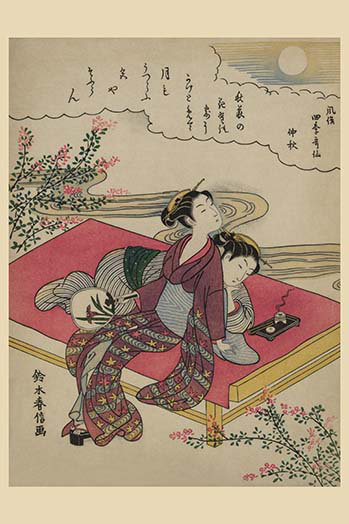


Buyenlarge Blossoming Plants Under An Autumn Moon By Suzuki Harunobu Painting Print Wayfair



Story Of Love On The Veranda Suzuki Harunobu As Art Print Or Hand Painted Oil



Japanese Suzuki Harunobu Woodblock 3 Print Portfolio Set Lovers Herron Girl Crow Ebay



Bonhams Suzuki Harunobu 1725 1770 Edo Period 1615 1868 Circa 1765



Suzuki Harunobu 1724 1770 Uzuki The Fourth Month



Suzuki Harunobu Japanese Fine Art Print Couple In A Etsy



Woman Looking At The Ide Suzuki Harunobu 1765 1770 Painting By Suzuki Harunobu



Lovers Walking In The Snow Crow And Heron Suzuki Harunobu Man Woman Art Art Print By Navi107 Society6


Japaneseprints London Suzuki Harunobu



Suzuki Harunobu 22 Artworks Bio Shows On Artsy



Harunobu Suzuki Artelino



Woodblock Print By Suzuki Harunobu 1725 70 Reprint Catawiki



Suzuki Harunobu 1724 1770 Japanese Prints Japan Painting Japanese Art



Japanese Print Suzuki Harunobu Japan Art Two Lovers Umbrella Snow 16 X24 Ebay
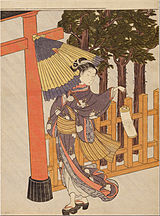


Suzuki Harunobu Wikipedia



100 Beauties Suzuki Harunobu By Andrew Forbes David Henley Nook Book Ebook Barnes Noble


A Young Woman In A Summer Shower By Suzuki Harunobu 1725 1770 Japan Museum Quality
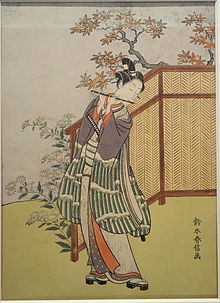


Suzuki Harunobu Wikipedia



Two Women In The Autumn Wind Suzuki Harunobu Mia



Sold Price Suzuki Harunobu Japanese Woodblock July 2 01 4 00 Pm Edt



Suzuki Harunobu Suzuki Harunobu 1724 1770 Mutualart



File Suzuki Harunobu By The Sea A Ii 841 380 Finnish National Gallery Jpg Wikimedia Commons


Q Tbn And9gcqzc21x1pxpna9xoy0u8hgdnrazya34l6nkmmwdedfrwf3vhaa8 Usqp Cau



Egoyomi By Suzuki Harunobu Art Print Wall Art Posters And Framed Art
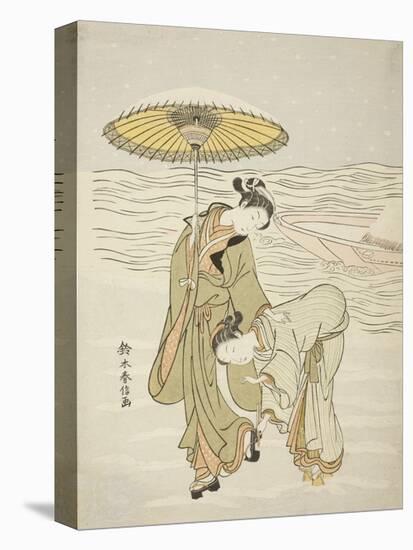


The Snow Clogged Geta C 1767 68 Giclee Print Suzuki Harunobu Art Com



Suzuki Harunobu Ca 1725 1770 Japanese Art Japanese Prints Japanese Drawings


Suzuki Harunobu And The Culture Of Color



Suzuki Harunobu Fine Art Open Edition Giclee Woman In Winter Coat Asian Collection Giclee Print Reproductions Museum Editions
.jpg)


Japanese Art Kiseru Suzuki Harunobu



Woman Riding A Crane Suzuki Harunobu 美和 Miwa Japanese Art



Suzuki Harunobu Shunga Circa 1770 Varshavsky Collection



Untitled By Suzuki Harunobu Print On Canvas Ready To Hang Overstock



A Beauty With Chrysanthemums By A River Bank By Suzuki Harunobu Art Print Wall Art Posters And Framed Art



Suzuki Harunobu Japanese Artist Britannica


Suzuki Harunobu Parody Of Minamoto No Tametomo Japan Edo Period 1615 1868 The Metropolitan Museum Of Art


Suzuki Harunobu Print Japan Edo Period 1615 1868 The Metropolitan Museum Of Art
.jpg?mode=max)


Suzuki Harunobu 1725 1770



Suzuki Harunobu And The Culture Of Color Wall Street International Magazine


Japaneseprints London Suzuki Harunobu
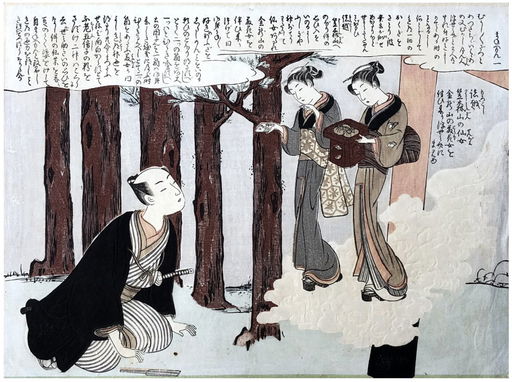


Japanese Woodblock Print Suzuki Harunobu Jun 02 18 Woodblock Prints World In Ca



Suzuki Harunobu 22 Artworks Bio Shows On Artsy



Courtesan Dreaming By Suzuki Harunobu Print On Canvas Ready To Hang Overstock



Talk Suzuki Harunobu Wikiwand



Harunobu Original Or Reproduction Artelino



Suzuki Harunobu A Selection Of His Color Prints And Illustrated Books Hardcover Hillier Jack Amazon Com Books



Art On Tuesday Suzuki Harunobu Japan Kaleidoskop


One Woodblock Print By Suzuki Harunobu On Artnet



Suzuki Harunobu Wikipedia



Viewing Japanese Prints Suzuki Harunobu 鈴木春信



Suzuki Harunobu 1724 1770 Young Man And Woman Hunting For Insects At Night



Suzuki Harunobu Geisha Traditional Japanese Engraving Stock Photo Image By C Kishko



Suzuki Harunobu Buy At Veryimportantlot Com Auction Of The Artwork Suzuki Harunobu 1725 1770 Artist Suzuki Harunobu At A Low Price Catalog From 22 09 Lot 106



Loving Couple Drawing By Suzuki Harunobu



Scholten Japanese Art Suzuki Harunobu Moxa Highlights Of Japanese Printmaking Part 4 Shunga



The Poetess Ono No Komachi Suzuki Harunobu Japanese 1725 1770 Painting By Suzuki Harunobu



Suzuki Harunobu The Art Institute Of Chicago



File Suzuki Harunobu 001 Jpg Wikimedia Commons
.jpg?mode=max)


Suzuki Harunobu 1725 1770 Mitate Ono No Tofu Young Woman Imitating Ono No Tofu Christie S



File Suzuki Harunobu Flowers Do Not Wait From An Untitled Series 1767 Jpg Wikimedia Commons


Suzuki Harunobu Evening Chime Of The Clock Tokei No Banshō From The Series Eight Parlor Views Zashiki Hakkei Japan Edo Period 1615 1868 The Metropolitan Museum Of Art
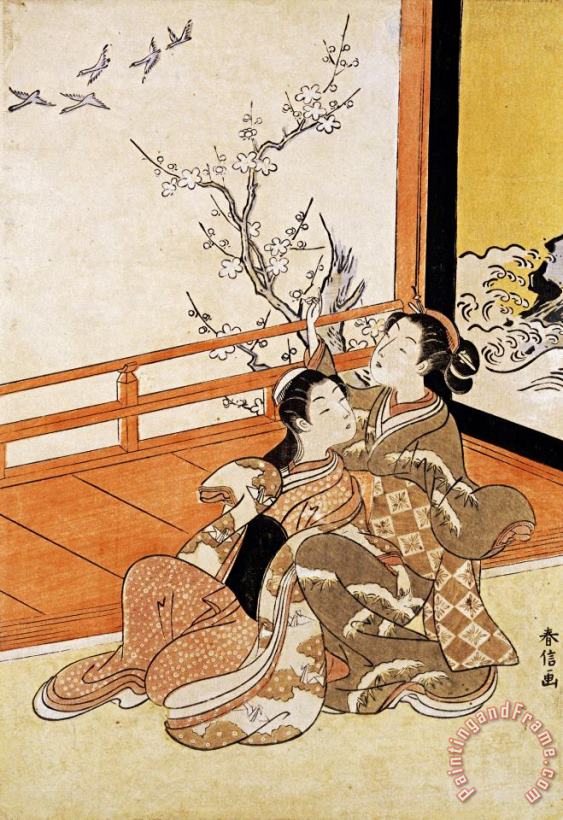


Suzuki Harunobu Two Women Seated By A Verandah Painting Two Women Seated By A Verandah Print For Sale



Woodblock Print By Suzuki Harunobu 1725 1770 Reprint Catawiki
.jpg?mode=max)


Suzuki Harunobu 1725 1770 The Gossips Christie S



Suzuki Harunobu And The Culture Of Color Portland Art Museum


Suzuki Harunobu
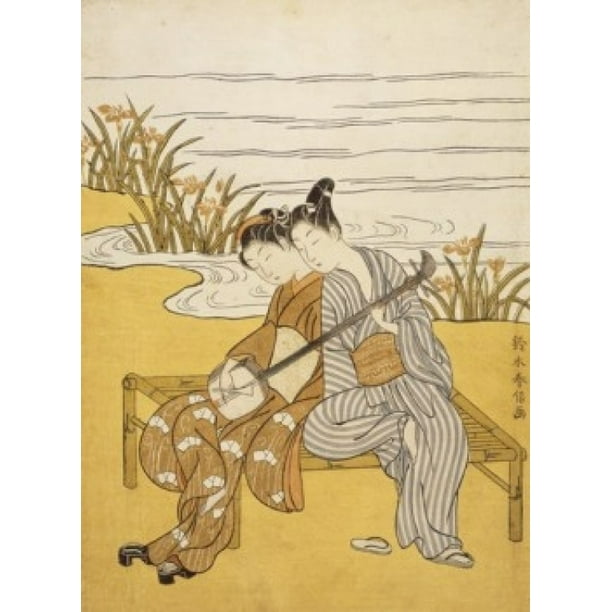


Two Lovers Playing A Shamisen C1776 1777 Suzuki Harunobu 1725 1770 Japanese Woodblock Minneapolis Institute 24 X 36 Walmart Com Walmart Com


コメント
コメントを投稿